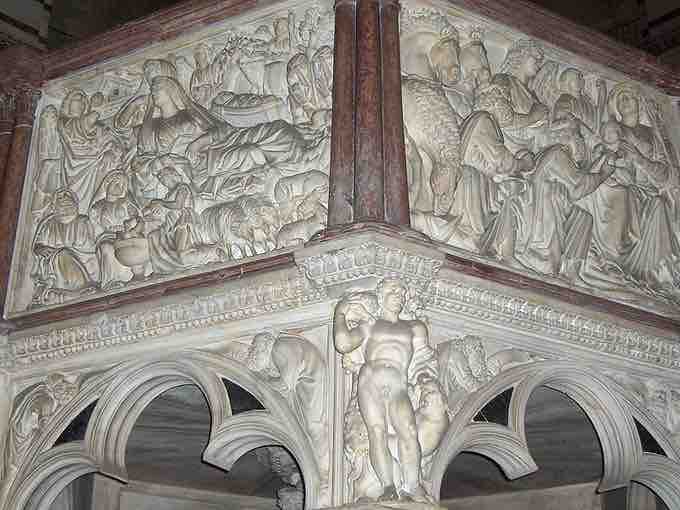Nicola Pisano (ca. 1220–1284) and his son Giovanni Pisano (ca. 1250–1315) were Italian sculptors during the Gothic age who developed a Classical-influenced style of sculpture known as Proto-Renaissance. Their relief sculptures drew heavily from the carved Roman sarcophagus and were characterized by sophisticated and crowded compositions and a sympathetic handling of nudity. They are sometimes considered to be the first modern sculptors.
The specifics of Nicola Pisano's origins are uncertain. He was born between 1220 and 1225 in the southern Italian region of Apulia and trained in the local workshops of the Holy Roman Emperor Frederick II. He moved to Tuscany around 1245 and was active in the cities of Lucca, Pisa, Siena, Pistoia, and Perugia. His most famous work is the pulpit of the Pisa baptistery, which is a masterful synthesis of the French Gothic style and Classical style. Made of white Carrara marble, the pulpit depicts scenes from the life of Jesus Christ in a Classical style. The figures wear tunics in a Roman fashion, and his representation of the Madonna is reminiscent of the regal bearing of goddesses in late Roman sculpture. The inspiration for the pulpit probably came from the triumphal arches in Rome. Nicola Pisano had seen the arches on his travels, particularly the Arch of Constantine, which has many features the pulpit imitates, including figures standing on top of columns and an attic storey with sculpted scenes.

Detail of the pulpit at Pisa Baptistery
Pulpit (detail): the Annunciation to the Shepherds and the Adoration of the Magi. The trefoil arches supporting the pulpit show French Gothic influence.
Other well-known projects undertaken by Nicola Pisano include a marble pulpit for the Siena Cathedral, a commission he received after making his name in Pisa, and the Fontana Maggiore or Great Fountain at Perugia, which he worked on alongside his son Giovanni.

Fontana Maggiore, Perugia
Nicola and Giovanni Pisano worked side by side on the Fontana Maggiore at Perugia. On the twenty-five sides of the basin are sculptures representing prophets and saints, the labors of the months, the signs of the zodiac, scenes from Genesis, and events from Roman history.
Nicola's son, Giovanni Pisano, was born in Pisa around 1250 and trained as a sculptor in his father's workshop. He worked alongside his father on the pulpit in the Siena Cathedral and the Fontana Maggiore in Perugia. His earliest works imitated his father's style, and it is difficult to separate the contributions of the two sculptors. However, after his Nicola's death, Giovanni's style grew more distinct. While it continued to incorporate Classical influences, it was more French Gothic in style and characterized by a bold, dramatic animation that had been missing in Nicola's serene sculptural style.
Giovanni was the chief architect of the Siena Cathedral between 1287 and 1296. He also worked on statues decorating the exterior of the Pisa Baptistery, the facade of the church of San Paolo a Ripa d'Arno (St. Paul on the Bank of the Arno) at Pisa, and a monument commissioned by the emperor Henry VII, commemorating his wife Margaret of Brabant.
Giovanni's greatest work is arguably a pulpit at the Cathedral of Pisa sculpted between 1302 and 1310. The pulpit incorporates a dramatic depiction of nine scenes from the New Testament carved in white marble with a chiaroscuro effect and a naturalistic carving of a nude Hercules. The figure of Prudence in the pulpit is thought to have been an inspiration for the Tuscan painter Masaccio in his Expulsion from the Garden of Eden.

Pulpit of Pisa Cathedral
The pulpit at the Pisa Cathedral shows Giovanni Pisano's distinct preference for a bold animated style.